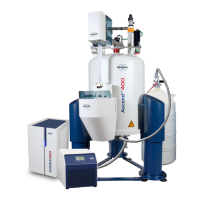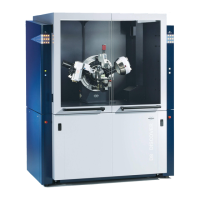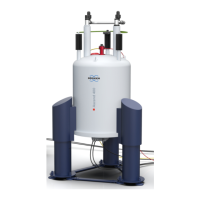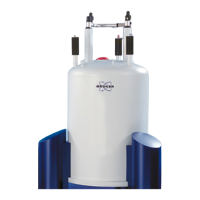System Description
H171804E_14_001 29 / 86
4.5.2 Helium Tank
In a standard magnet the helium tank is suspended from two necks which extend high above
the magnet. Access to the helium tank can be made via two ports. One of these ports permits
refilling of the liquid helium and is also the entry for a helium level sensor. The other port is
used only when the magnet is being charged or discharged. The helium necks may support
several valves which control the release of the small quantities of helium that will inevitably
evaporate.
Note: Handling of the valves and filling the magnet with liquid Helium should only be done by
a trained person.
4.5.3 Nitrogen Tank
The three shorter necks extending above the magnet allow access to the nitrogen tank.
4.6 Introduction to the Lock System
This section has been included to give the user a basic understanding of the principles of the
lock system. Practical aspects such as how to actually lock the sample will be dealt with in
the section Locking the Sample.
The aim of the lock system is to ensure that the strength of the magnetic field surrounding the
sample does not change during an experiment or that the field is not modulated by external
disturbances. NMR analysis involves measuring the precise frequency of signals that are
emitted by the sample. The frequencies of these signals are directly proportional to the
magnetic field strength, i.e. if the field strength varies, so does the emitted frequency.
Therefore, the user must be confident that the magnetic field strength is always maintained at
precisely the same strength, which is referred to as "locking" the sample. The lock system
is essentially a separate spectrometer designed to observe deuterium. It should be
mentioned that the signals emitted by deuterium are normally far removed from frequencies
of interest. However, if the deuterium frequency is unsuitable, then a Fluorine (19F) lock
may be used. Since it is by far the most popular, only the deuterium lock will be dealt with
here, but the reader should note that the principle of the deuterium and the fluorine lock are
identical.
In AVANCE systems the BSMS provides the hardware required to implement the lock and a
separate deuterium module in the HPPR transmits and receives the lock signals. Some
deuterium must of course be introduced into samples that are under analysis. This can most
easily be done by dissolving the sample in a deuterated solvent. A deuterated solvent is one
in which a large percentage of the hydrogen atoms have been replaced by deuterium.
Commonly used deuterated solvents are acetone-d6, benzene-d6, chloroform-d and DMSO-
d6, although many other solvents are available. The sample which will be used to illustrate
some basic NMR techniques in this manual is Menthyl Anthranilate in DMSO-d6.
The frequency of the signals emitted by deuterium for a particular size of magnet is precisely
known. Therefore, if the magnetic field strength is correct, any deuterium nucleus in the
sample should emit this exact frequency. If the magnet strength varies so will the deuterium
frequency. The lock system uses a receiver (housed in the BSMS rack) to monitor this
deuterium frequency and makes adjustments to the magnetic field strength accordingly.
The receiver in the lock system is designed so that when the field strength is correct (i.e. the
correct deuterium frequency is detected), no adjustments are made to the field. However,
should the field strength vary (drift), a current is changed in a special coil (the H0 coil) located
within the shim system of the magnet, which has the effect of returning the field strength to
the correct value. The deuterium frequency is measured several thousand times per second.
Hence, as long as the system is locked, the user can be confident that the field is maintained
at a constant strength during acquisition.

